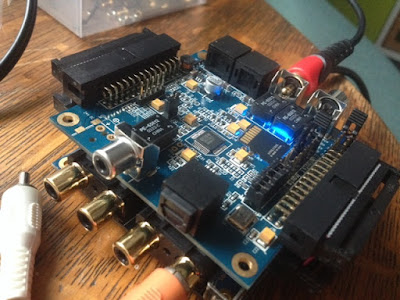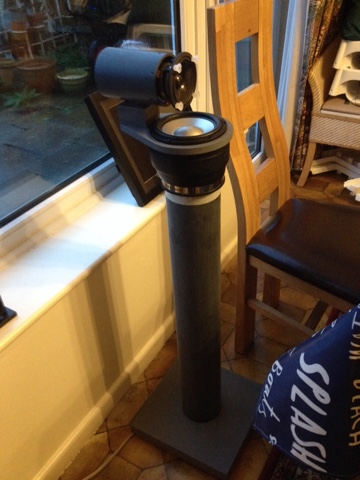Unfortunately, the subwoofers require boxes, a construct to which I am both allergic, from an audio point of view, and challenged by, from a constructional point of view. The audio side of things is probably ok, they are just subwoofers, so the boxiness isn't going to be problem, I hope. The construction thing is much harder, because boxes require sawing, right angles, joints, all that kind of stuff. Once Upon A Time, I blithely built boxes for all sorts of speakers, but now I seem to be incapable of getting anything to meet squarely with anything else. I suspect this was always true, but maybe I'm just more critical now!
Anyway, I've knocked up the required 1ft cubes with open backs, as specified by SL. I deviated slightly from the Master Plans in that I've used 18mm MDF instead of plywood for the top/bottom/front, because that's what I had, but that shouldn't matter. However, I want to spray them the same flocked grey that I've used for the main speakers... and there's the problem. Unfortunately, I held the panels together with tape while I was lining things up (all part of the patented GoukBuild © method), and the dratted tape has picked up the surface of the crappy 6mm MDF I used for the sides. So now it has rough and smooth bits, which stand out a mile when sprayed. Farts. Yeah, I know, the boxes are utterly cack and completely utilitarian, with screws standing out and all sorts of horror, but I'm drawing the line here, ok?
What to do? My mate G suggested molten plastic, conceptually, which is a great idea but infeasible. Then I thought of gesso - a high-build, water-soluble paint-like material used by painters to smooth out canvas and stuff, with which I'm familiar via my wife's artistic endeavours. She happened to have an used bottle of grey gesso she'd been keeping on the off-chance of ever needing grey... And a foam applicator!
And here are the boxes in all their glory, after two coats of gesso. More to come I suspect, although it goes on very easily, and dries really quickly. I started out using a brush, but the gesso is quite gloopy, and the foam applicator is much quicker and smoother. I'm going to slap lots of gesso on to build up a layer that I can sand back to smooth off the fluffy bits - hopefully! They're looking quite cool, in a "Rebel Alliance spaceship" kind of way... With the awesome ally-coned woofers, they're going to look amazing! Nobody will notice the uneven edges, variously-countersunk screws etc. etc. right?
Anyway, I've knocked up the required 1ft cubes with open backs, as specified by SL. I deviated slightly from the Master Plans in that I've used 18mm MDF instead of plywood for the top/bottom/front, because that's what I had, but that shouldn't matter. However, I want to spray them the same flocked grey that I've used for the main speakers... and there's the problem. Unfortunately, I held the panels together with tape while I was lining things up (all part of the patented GoukBuild © method), and the dratted tape has picked up the surface of the crappy 6mm MDF I used for the sides. So now it has rough and smooth bits, which stand out a mile when sprayed. Farts. Yeah, I know, the boxes are utterly cack and completely utilitarian, with screws standing out and all sorts of horror, but I'm drawing the line here, ok?
What to do? My mate G suggested molten plastic, conceptually, which is a great idea but infeasible. Then I thought of gesso - a high-build, water-soluble paint-like material used by painters to smooth out canvas and stuff, with which I'm familiar via my wife's artistic endeavours. She happened to have an used bottle of grey gesso she'd been keeping on the off-chance of ever needing grey... And a foam applicator!
 |
| Bottle of instant gesso and applicator |
Here's a shot of the boxes, showing one of the bits where the tape has lifted the surface of the MDF, highlighted by the raw gesso application. I'm never using MDF for anything ever again... Am I being fussy?? Hey, it's my project!
 |
| Box close-up showing lifted surface |



























